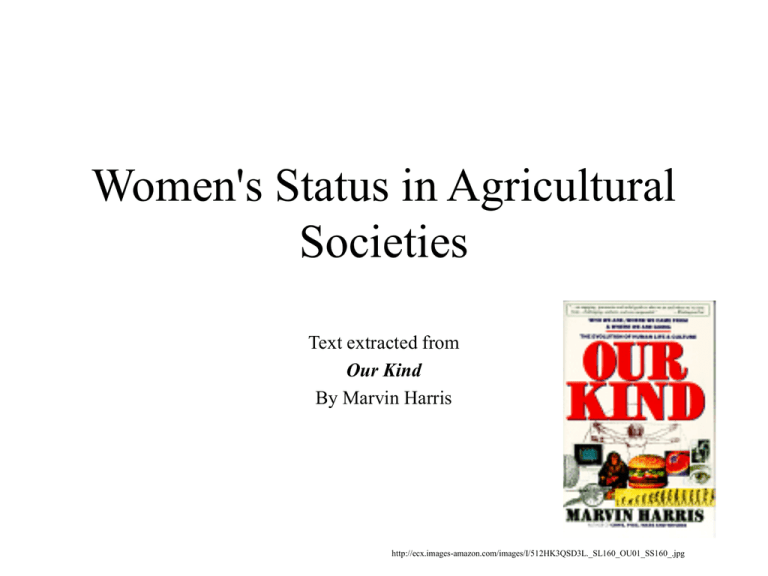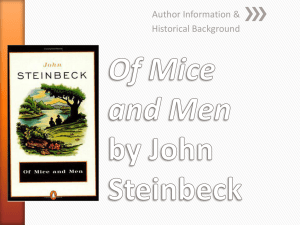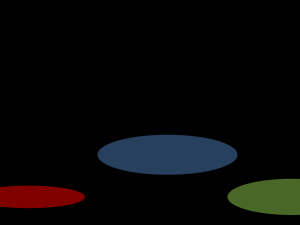
Women's Status in Agricultural
Societies
Text extracted from
Our Kind
By Marvin Harris
http://ecx.images-amazon.com/images/I/512HK3QSD3L._SL160_OU01_SS160_.jpg
Women’s Status
• Women have less status than
men in agricultural societies
–
–
–
–
–
Social
Political
Economic
Educational
Religious
• Two main causes
http://img.dailymail.co.uk/i/pix/2007/11_02/muslimDM1511_468x310.jpg
– Men dominate weapons and war
– Men dominate plow-based
agriculture
Men are larger, stronger than
women
• Women 4.6 inches
shorter than men
– on average
• Women have lighter
bones
– and more fat
• Women 2/3 to 3/4 as
strong as men
http://www.geocities.com/MotorCity/Factory/1940/wood2.jpg
Men specialized in hunting large
game
• Men were the big game
hunters in 95% of bandand-village societies
• Male advantage in
height, weight, brawn in
use of hand-held hunting
weapons
• Women less mobile when
pregnant, lactating
– hunt smaller game, gather
food (majority of diet)
http://www.alaskool.org/LANGUAGE/manytongues/Images/Hunter.jpg
Men usually specialists in weapons
• Men monopolized lethal
weapons since Paleolithic times:
–
–
–
–
–
spears
bow and arrows
harpoons
clubs
boomerangs
• Men thus more dangerous
– and more coercive in conflict
• "I'm a man. I've got my
arrows. I'm not afraid to die“
http://www.museum.state.il.us/muslink/nat_amer/pre/images/dmm_p02_200.jpg
– !Kung hunter
Men trained to be warriors
• Warriors aggressive and fearless
• More capable of hunting and
killing other human beings
– without pity or remorse
• Women warriors only significant
in recent times
– with firearms, not muscle powered
• In Band and village societies, the
more warfare there was
– the more women suffered from
male oppression.
http://upload.wikimedia.org/wikipedia/commons/thumb/0/06/Assyrian_spearman_%C
2%B7_HHWI469.svg/300px-Assyrian_spearman_%C2%B7_HHWI469.svg.png
Oppression of Women
• Amount of war
correlates to the
oppression of women
http://www.rrtraders.com/Shields/kikuyu-tribe.jpg
Bands of hunters and gatherers:
• !Kung
– Kalahari desert, Africa
– Low population density
hunters and gatherers
• Little warfare
• Women have almost equal
status as men
http://www.der.org/films/images/kung-instrument.jpeg
Aborigines (Australia):
• More warfare between bands
• Fairly low population density
hunters and gatherers
• Captives from war cooked, eaten
– Mostly women and children
• Males get best food
• Men beat or kill wives for adultery
• Wives cannot do the same to men
for adultery
http://theology1.tripod.com/images/aborigines.jpg
– Double standard
Aborigine Women
• Aboriginal women do all the
hard work
– Gather fruits, dig roots
• chop larvae out of tree-stems
– Carry child on shoulders whole day
– Prepare food
• beating, roasting, soaking fruits and roots
– Makes hut, gathers materials
– Provide water and fuel
– Women carry all baggage when travel
• including children
• Men only carry light weapons
– out in front when travel
Village Societies of Agriculturalists
Yanomami (Rainforest of Brazil, Venezuela)
• Boys train for war at early age
– learn cruelty by practicing on animals
• Raids between villages
common:
– 33% males die from armed combat
– competition for resources due to
population pressure
• Polygynous:
– men can have many wives
• Wives beat or maimed for
disobedience or adultery
– burned , ears chopped off
Village Societies of Agriculturalists
Nama (Papua New Guinea)
• Male initiation cult
trains men as warriors
– and to dominate
women
• Warfare between
villages rampant:
– competition for
resources due to
population
New Guinea warriors
http://www.infobrasil.org/fotos/fotos/Corel/images/1218.jpg
Nama (Papua New Guinea)
• Males given bride at
initiation –
– shoot her in the thigh with
arrow
– to demonstrate "unyielding
power over her"
• Women work in gardens,
raise pigs, do all dirty work
• Men stand around gossiping
New Guinea Warrior
http://www.world-traveler.eu/travels-papua-new-guinea-Dateien/papua-new-guinea-highlandswarrior.jpg
Nama (Papua New Guinea)
• "Women were severely punished for adultery by having
burning sticks thrust into their vagina, or they were
killed by their husbands; they were whipped with a cane
if they spoke out of turn or presumed to offer their
opinions at public gatherings; and were physically
abused in marital arguments.
• Men could never be seen to be weak or soft in dealings
with women. Men do not require specific incidents or
reasons to abuse or mistreat women: it is part of the
normal course of events; indeed, in ritual and myth, it is
portrayed as the essential order of things."
--Daryl Feil, University of Sydney
Why Intense Warfare in
Agricultural Village Societies?
• New Guinea:
– high population leads to
depletion of resources
• Forests depleted, burned
– replaced by fields
• Yams and pork
– replace wild animals and
plants
• Selection for warfare:
http://www.theage.com.au/ffximage/2006/09/17/18W_PNG_narrowweb__300x334,0.jpg
– take over neighboring
resources
Male Domination in Agricultural
Village Societies
• Male domination leads
to female infanticide:
– Females can't become
warriors
• sex ratios skewed
toward males
• Female infanticide
ultimately lowers
population growth rate
http://www.infobrasil.org/fotos/fotos/Corel/images/1208.jpg
Male Domination of Food
• New Guinea: male
hunters, warriors
– monopolize meat
(pork)
• Malnutrition:
– especially women,
children and older men
• Women and children
http://www.ebible.org/mpj/gallery/MamaNaPikininiLongBulal.jpg
– Eat more insects, frogs,
mice, placenta,
maggots
Patrilocality
• Patrilocality:
– women leave their family,
village
– move in with man's family
• Allows male raiding parties to be
made up of blood relatives:
– trust in combat teams
• But who will look after land when
men away?
– Women
• especially sisters: loyal
http://upload.wikimedia.org/wikipedia/commons/thumb/b/b8/Orma_Village_Keny
a.jpg/800px-Orma_Village_Kenya.jpg
Matrilocality
• Matrilocality: men leave their
family, village
– move in with woman's family
• Occurs in some chiefdoms
where men gone on long raiding
parties
– up to a year
Iroquois longhouse
• Example: Iroquois
• Women were in charge of home
and fields:
– harvesting and storing crops
• Women in longhouse could
withhold food for men's raids
http://www.historyforkids.org/learn/northamerica/b
efore1500/history/pictures/tiogapointmuseum.jpg
– if didn't approve
Matrilocality
• Women's power not the
opposite of mens:
– not equally cruel or
humiliating. Why?
• Not because women less
vicious:
– women often participate in
torture
• Women cannot boss and
degrade men
– when men have the weapons
of war and warrior training.
Mohawk Warrior
http://dsccrafts.com/ProductImages/_american_indians/51872_Mohawk_Warrior_Pg3_WEB.jpg
Large Stratified Societies
• Effect of warfare less
direct:
– most men not trained
to be warriors
• Most men unarmed
peasants
– also terrified of
professional warriors
Type of Agriculture affects
women's status
• West Africa
– Agriculture not
dependent on men
– Women empowered
• North India
– Men’s strength
required for plowing
– Women unempowered
• South India
http://www.thp.org/activist/105/hoe500.jpg
– Women control
agriculture
– Women empowered
West Africa
• People:
– Yoruba, Igbo, and Dahomey
• Women's status strong:
– can own fields and crops
– Dominate local market
– Acquire wealth from trade
• No animal-plowed fields
http://www.hobotraveler.com/blogphotos01/207-266hoe-farming-africa-girl.jpg
– due to tse-tse fly
– Short-handled hoe used in farming
– Therefore women not dependent
on men for agriculture
West Africa
• Men must pay bride-price to get
married
– Women valuable
• Male polygyny
– only with permission of senior wife
• Women participate in village councils
– and high state office
• Women mobilize as group
– to seek redress against mistreatment by
men
North India
• Men have monopoly on oxdrawn plows
• Greater body strength:
– 15-20% more efficient than women
• Advantage may mean difference
between survival
– and starvation
• Even young men not strong
enough to plow all day:
http://www.gonomad.com/tours/0512/images/india-plowing.jpg
– short window of weather
opportunity for plowing
North India
• Female infanticide common
• Dowries from women
required for marriage
• Widows powerless:
– sometimes throw themselves
on husbands funeral pyre
Acid Burn Victim,
Bangladesh
http://news.bbc.co.uk/media/images/36204000/jpg/_36204440_acidvictimbbc300.jpg
• Increasing incidence of
intentional acid spraying
South India
• Rice paddy agriculture:
– doesn't need men's strength
• Women in charge of much
agriculture
• Women have more
freedom,
– status, social power
• True in other rice
producing areas
– Southeast Asia, Indonesia
http://frank.itlab.us/India_2002/dec_25_planting_rice.jpg
How did male dominance evolve
in large agriculture societies?
• Men in charge of large
plow animals
– From ancient times
• Men thus drive
animal-drawn carts
when wheel invented
– In charge of trade
http://www.greathall.com/photoalbum/photos/itl_plow.jpg
How did male dominance evolve
in large agriculture societies?
• Men thus in charge of
bookkeeping, records
• Men thus became the
scribes, accountants, literate
• Men thus became the
philosophers, theologians,
and mathematicians
How did male dominance evolve
in large agriculture societies?
• Men also controlled
warfare
• Men thus gained control
over governments
– and state religions
"At the dawn of modern times men dominated
politics, religion, art, science, law, industry,
commerce, and the armed forces wherever people
depended on animal-drawn plows for their basic
food supply"
http://www.visitingdc.com/images/george-washington-picture.jpg
http://www.fourmilab.ch/documents/figures/einstein.png
http://thescroogereport.files.wordpress.com/2007/07/pope.jpg
http://richmondthenandnow.com/Images/Famous-Visitors/Thomas-Jefferson-big.jpg http://www.smh.com.au/ffximage/2004/05/25/michelangelodavid,0.jpg
http://a.abcnews.com/images/WNT/ap_bill_gates_060921_ssh.jpg
http://img.slate.com/media/1/123125/2158911/2159086/2159087/070221_CL_HitlerEX.jpg







